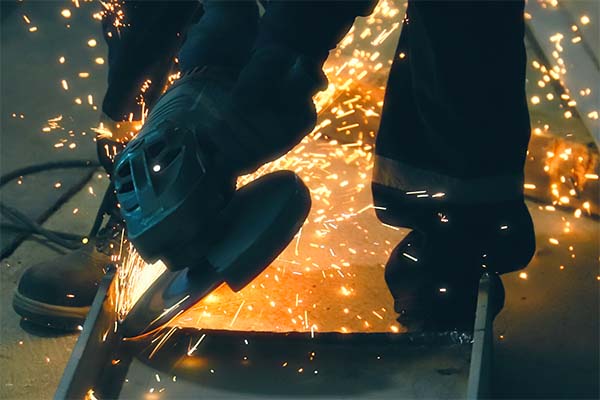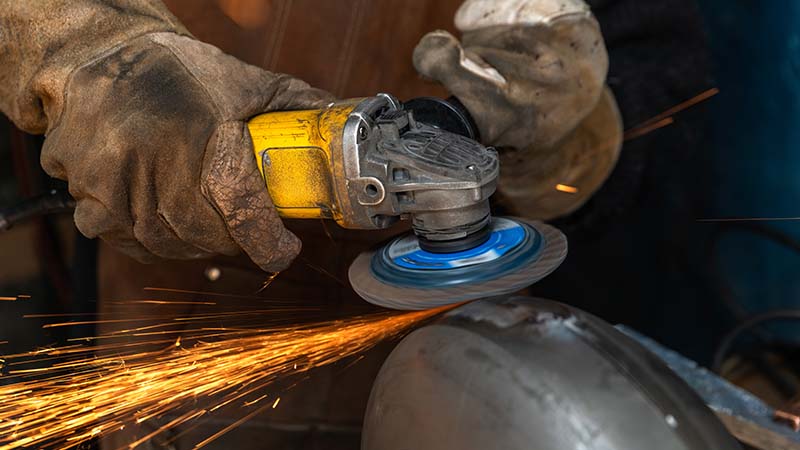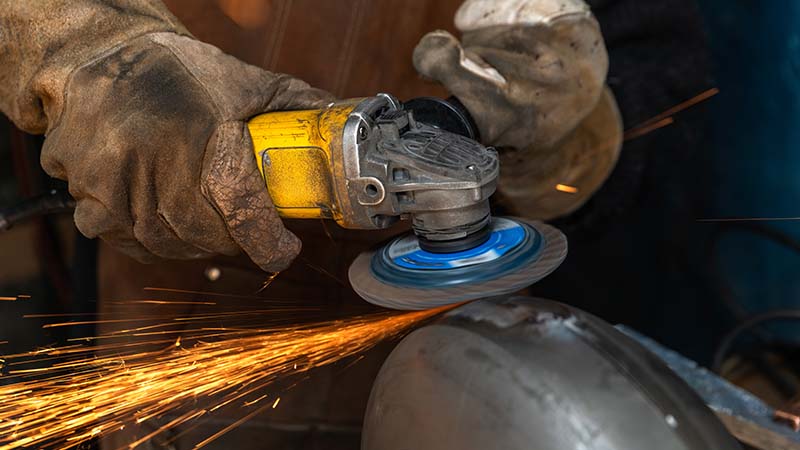Whatever the industrial process you are running, most likely you use on a daily basis some abrasive discs. They are widely used in every type of industry.
Now, it is safe to say that there is a daunting variety of abrasive discs, as well as manufacturers or brands, which can make it difficult to choose the right one for the specific application you need.
For any fabricator, using good-quality abrasive discs can mean a lot. The metal surface has to look good before putting any kind of coating on it.
What are considered abrasive materials?
An abrasive is a material used to finish (the act of polishing, removing material, or making a surface smooth) or shape a workpiece through friction. The materials used on abrasives to create friction are often minerals.
The harder the abrasive is, the deeper and faster it will cut or smooth the surface.Abrasives are commonly mislabeled as sandpaper by the general public, but that is a misnomer because sand is not used to manufacture abrasive products anymore.
Abrasives are used for many different industrial, consumer, and technological applications. Abrasives can be used for cutting, grinding, polishing, sharpening, lapping, buffing, honing, and sanding among many other things. The wide range of uses has given birth to many different types of abrasive products.
What is an abrasive disc?
As the name suggests, abrasive discs are abrasive material that comes in the form of a disc. It is manufactured this way to be used in a fixed or portable tool for sanding, roughing, prepping, or cutting some surface, by applying friction.
Basically, an abrasive disc is composed of the abrasive material (natural or synthetic), a binding agent (what keeps the material stuck), and a base or support material. There is a huge variety of abrasive discs. The main differences are what the grains (abrasive) are made of, composition, targeted use, etc.
These grains are made by heating or chemically treating the base mineral. Following that, they are crushed and sifted. This allows to separate them by, which is important because the finished product will depend on the size of the grain. The smaller the grain is, the smoother the finish will be. The next step is to adhere the grains to the support material.

Main types of abrasives discs and their uses
As stated before, there is a huge variety of abrasive discs. Basically, the most used in the industry are categorized like this:
- Cutting discs
- Flap discs
- Strip discs
- Grinding discs
- Sanding discs
So, let’s dig deeper into this, define each type, and explain their main use.
Cutting discs
These are abrasive discs whose main function is to cut through steel, stainless steel, aluminum, and other metal alloys with an angle grinder. The most popular abrasive cutting discs are made of aluminum oxide and zirconia.
The thickness of the cutting discs you should choose might depend on the thickness and shape of the steel you need to cut. These discs’ thicknesses can range from 0.8 mm to 2.5 mm. The thicker the material is, the slower the cut is going to be and the hotter the surface is going to get.
Flap discs
These are flat, horizontal, and in some cases, flexible discs widely used for industrial operations, both large and small. They are in most cases the option of choice for welders and metal fabricators.
The main use of these flap discs is to perform stock removal, grinding, blending, deburring welds, and provide finishing to surfaces. In the same case of cutting discs, these flap discs are made of zirconia (for mild and stainless steel) or aluminum oxide (general grinding).
Flap discs are composed by putting together several pieces of sandpaper. This way they are not only effective but also durable.
Strip discs
These discs are made out of poly-fiber and are impregnated with abrasive grain. These discs are quite different from the ones mentioned earlier in appearance, composition, and purpose.
Their purpose is to remove rust, paint, and epoxy without damaging the surfaces. They can strip out these coatings in hard surfaces like stainless steel, and in soft surfaces like wood or fiberglass, without damaging the original surface.
Grinding discs
Grinding discs are known also as grinding wheels. They are made out of aluminum oxide and have a depressed center that allows their use on irregular surfaces.
As the name suggests, the main purpose of these abrasive discs is to grind on mild steel, carbon steel, stainless steel, bronze, wrought iron, annealed malleable iron, and other metals like these. Other operations like pipe notching and beveling are possible with these discs too.
Sanding discs
These discs are made of zirconia or ceramic abrasives and are aimed at finer finishings, like sanding. They are for use in angle grinders.
These are the go-to discs to remove medium to light stock, blend welds, deburring, and take out rust from surfaces. Due to the materials they are made of, they can be used in most metals, including stainless steel.
What are Coated, Non-Woven & Bonded Abrasives
These designations are not to explain the form or purpose they have, but they are related directly to the way the abrasive disc is made and the materials used.
In the case of bonded abrasives, they are grains (whichever the material) bonded to a hard backing base using glues, resins, or varnish. The resultant product is a hard disk that usually is used in angle grinders. Grinding discs are among these.
The coated abrasives are manufactured by adhering abrasive grain to a flexible material, like a special paper, vulcanized fiber, cloth, or some type of film. Then it becomes a flexible abrasive that can be used in a machine or even by someone’s hand. Sanding belts are examples of coated abrasives.
The non-woven abrasives, as their name implies, are abrasive grains attached to non-woven nylon fiber. In this case, just synthetic materials are used to manufacture the disc. As an example of non-woven discs, we can mention strip discs.
Main applications of abrasives discs
As a whole, the abrasive discs can be used for a number of different tasks in industrial processes, whether large or small. Let’s review some of them.
Cutting
Some abrasive discs are meant to cut through metal. Depending on the metal, some abrasives can be used or not. For example, zirconia would be used for cutting mild steel, while aluminum oxide would be the choice for cutting other metals.
Grinding and polishing
Grinding a surface or piece means removing stock or shaping it. On the other hand, polishing refers to the smoothing or blending of a surface or piece.
Both operations can be made with the same type of abrasive disc, but the grain must differ. While grinding (for example to weld blending) would require a coarse grain, polishing would need a finer grain.
Some surfaces might need to be polished to offer a better appearance and others would need some polishing to be prepared for a new coating.

Rust and contaminants removal
Rust is something that can be over just a part of a surface or piece. That means that the abrasive used for rust, scale, or other contaminants removal should be mild enough to clean but preserve the entirety of the piece.
Deburring Equipment
Sometimes in the production process, a piece can develop heavy burrs or even sharp edges. Then, some deburring might be needed to bring the piece to the ideal finish. In particular, flap discs are the most commonly used abrasives for this operation.
How to choose the right abrasive disc for your application
We have explained before that abrasive discs can be useful for a wide variety of processes, which can be performed in industries and even at homes. So, let’s now highlight a couple of the main applications abrasive discs can have.
Woodworking
Wood is one of the most delicate surfaces to work with, and so the abrasive also must be soft. Open coat aluminum oxide (which means that the grain is less crowded in the disc) is both an effective and cost-saving option. Now, if the wood is especially hard, like some African types, a close coat aluminum oxide disc (now, the grain is more crowded in the disc’s surface) would be ideal.
Metalworking
Metalworking jobs can range from heavy, like deburring pieces or weld blending to light, like auto body repair. So, for heavy-duty operations, aluminum oxide and silicon carbide would be ideal as abrasives, because they offer strong results in a short time. Now, for auto body repair, there is a whole line of softer abrasives to use.
These are the main applications of abrasive disc, but if you need more direction regarding a specific job, feel free to reach out to us, and we will be delighted to answer your questions.

You are not alone in this
At Ifexport, have been working with industrial processes and products, like abrasive discs, since 1979. So, we can tell you one thing or two about them.
Helping our clients to get covered with their abrasive discs needs is one of our goals. We can’t wait to apply our expertise to your workshop also.





